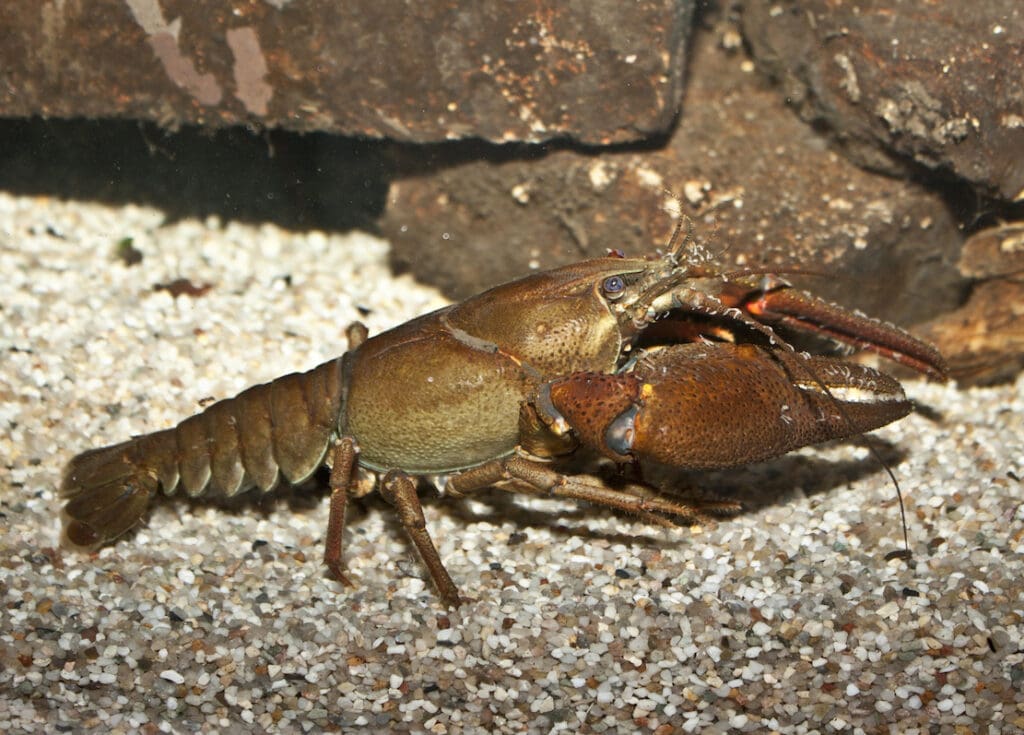
Astacus fluviatilis
Latin name: Astacus fluviatilis
Short name: Astac
Common name: European Crayfish | Freshwater Crayfish | River Lobster
Primary miasm: Psoric Secondary miasm(s): Sycotic, Tubercular
Kingdom: Animals
Family: Arthropoda: Crustacea
- Symptomatology
- Remedy Information
- Differentiation & Application
Astacus fluviatilis is a species of freshwater crustacean found in European rivers and lakes. The remedy is prepared from the entire animal, traditionally dried and triturated, sometimes roasted before trituration. In homeopathy, it is known for its deep constitutional action on the skin, blood, lymphatic system, and metabolism, with marked affinity for gouty and scrofulous diatheses. It is particularly noted for its power to provoke erysipelatous skin eruptions, urticaria, and arthritic node development, as well as for its role in conditions of chronic hepatic congestion and portal stasis [Hering].
In folk medicine, powdered crayfish shell was used as a calcium-rich supplement for rickets and debility; decoctions were given for kidney ailments, and topical applications were used for skin conditions.
Recorded in Guiding Symptoms [Hering] and Cyclopaedia [Hughes], largely from toxicological observations, empirical use, and clinical confirmations rather than a full Hahnemannian proving.
- Skin: Erysipelatous inflammation, burning and stinging eruptions, urticaria [Hering].
- Lymphatic System: Swelling of lymphatic glands, especially cervical and inguinal [Clarke].
- Liver and Portal System: Congestion, enlargement, sluggish bile secretion [Hughes].
- Joints: Arthritic swellings, gouty nodes [Allen].
- Blood: Alterations in quality and circulation, tendency to inflammatory exudates [Hale].
- Warm applications to affected skin or joints [Hering].
- Rest and avoidance of pressure on inflamed parts [Allen].
- Gentle movement after prolonged stiffness [Hale].
- Night, with aggravation of itching and heat [Hering].
- Cold damp weather, especially after exposure to river banks or marshy air [Clarke].
- Suppressed perspiration, leading to flare-ups of skin or joint symptoms [Allen].
- Apis mellifica – Similar erysipelatous swelling with stinging pain, but Apis is thirstless and more oedematous; Astacus has more burning, heat, and hepatic involvement.
- Rhus toxicodendron – Vesicular eruptions and erysipelas, but Rhus is worse from cold damp and better from warmth; Astacus may be aggravated by heat of bed in urticaria.
- Belladonna – Bright red, hot, tense skin; Belladonna has more throbbing, cerebral symptoms; Astacus is more gouty and hepatic.
- Urtica urens – Urticaria with itching, but without erysipelas or deep constitutional tendencies.
- Complementary: Lycopodium, Sulphur, Apis.
- Antidotes: Camphora, Belladonna.
- Inimical: None known.
- Follows well: Apis in erysipelatous conditions with hepatic congestion.
The essence of Astacus fluviatilis is inflammatory skin disease of erysipelatous or urticarial type with a constitutional tendency to gout and hepatic congestion. It acts on those with sluggish lymphatic and portal systems, where toxins manifest through recurrent skin flares or joint inflammations.
Especially useful in erysipelas of the face with marked hepatic involvement, and in chronic gouty constitutions where skin and joints are alternately affected. Consider in urticaria with burning and stinging, worse at night, especially if linked to liver sluggishness.
Mind:
- Restlessness from skin irritation
- Irritability with itching
Head:
- Congestive headache with hepatic disorders
- Flushed face during fever
Skin:
- Erysipelas of the face
- Erysipelas, vesicular
- Urticaria, worse at night
- Burning, stinging eruptions
Extremities:
- Gouty swelling of joints
- Pain, worse from rest
- Arthritic nodes
Generalities:
- Worse cold damp weather
- Better warm applications
- Worse suppression of perspiration
Hering C. – Guiding Symptoms: skin, joint, and hepatic spheres.
Clarke J.H. – Dictionary: urticaria and erysipelas descriptions.
Allen T.F. – Encyclopedia: toxicological and clinical observations.
Hughes R. – Cyclopaedia: hepatic and blood action.
Boericke W. – Pocket Manual: keynote symptoms.
Lippe A. – Keynotes: erysipelas modalities.
Hale E.M. – New Remedies: hepatic and lymphatic effects.
Kent J.T. – Lectures: comparative skin remedy analysis.
Farrington E.A. – Clinical Materia Medica: gouty and skin alternations.
Nash E.B. – Leaders: constitutional indications.
